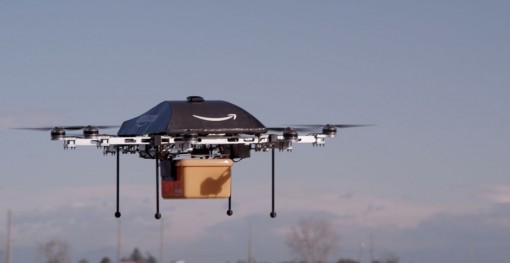When Amazon.com announced recently that it was planning to make deliveries by drones by 2015, it created quite a stir. How will it work? How will the drone find my apartment? Will my e-reader get left out in the rain? How much power would it take to carry large packages?
The details on how drone automated delivery would work are somewhat sketchy right now. The proposed vehicles have a range of 10 miles and can carry weights up to 5 pounds, which includes 86% of Amazon’s packages. But the 10-mile range would no doubt limit deliveries to big cities. And even then, an MIT professor pointed out that the drones don’t have enough battery life to go 10 miles with a 5-pound package. While the idea suggests energy efficiency, the current numbers suggests otherwise.
The plan is for the drones to find the customer’s address using GPS. The question has come up, though, whether the drones will be able to fly or locate addresses in bad weather. They probably would not, since ice, sleet, and other precipitation could interfere with their sensors.
If these issues can be worked out, is drone delivery a good idea or a bad one? The pros include fast, convenient delivery and less gasoline used for transportation. Customers could order online, and a home delivery could be made from an Amazon location in 30 minutes. There are plans to reduce the delivery time to just a few minutes. The drone system could limit package loss, increase sales, add jobs, and reduce pollution and fuel costs from truck deliveries.
But on the con side, plenty of objections to drone automated delivery have been raised. One is, in what condition will my package arrive? One of the main goals of delivery is to minimize damage through proper material handling systems. What if the drone crashes, drops the package on arrival, or catches fire? There have been a lot of jokes made about people wanting to shoot down drones. Someone may do it sooner or later, though; it’s human nature.
Another problem is how the drones will find an apartment in an apartment building, or a business in an office complex. It seems that someone will have to be outside to receive the package; otherwise it may be stolen. Critics also dislike the idea of the drones using GPS and cameras to navigate, because there’s a concern Amazon will collect information on residences for itself or for the government.
Safety is a big concern in drone delivery, and the FAA will want to address safety issues before it allows the plans to go ahead. A drone falling from the sky could injure people and pets. Large birds have been known to attack drones, dropping them out of the sky. And a defective drone could hit an electrical wire, causing a large outage, or a small plane, causing loss of life.
Zookal, an Australian textbook company, may have overcome some of these difficulties. Zookal will start delivering textbooks to students next year. The automated deliveries will be to an outdoor location, and ux developers can make it so students can use a smartphone app to see how close the delivery is, then go to the location. Zookal won’t use cameras to navigate; instead it will use anti-collision sensors. On the other hand, unlike Amazon, these drones will be delivering unbreakable items to a small, specific market.
A lot of the misgivings about drone delivery result from uncertainty over the whole idea. Amazon is looking for an energy and cost efficient solution, while too many questions about it remain unanswered. But, since UPS is also researching drone automated delivery to compete with Amazon, it’s probably an idea that won’t go away soon.
